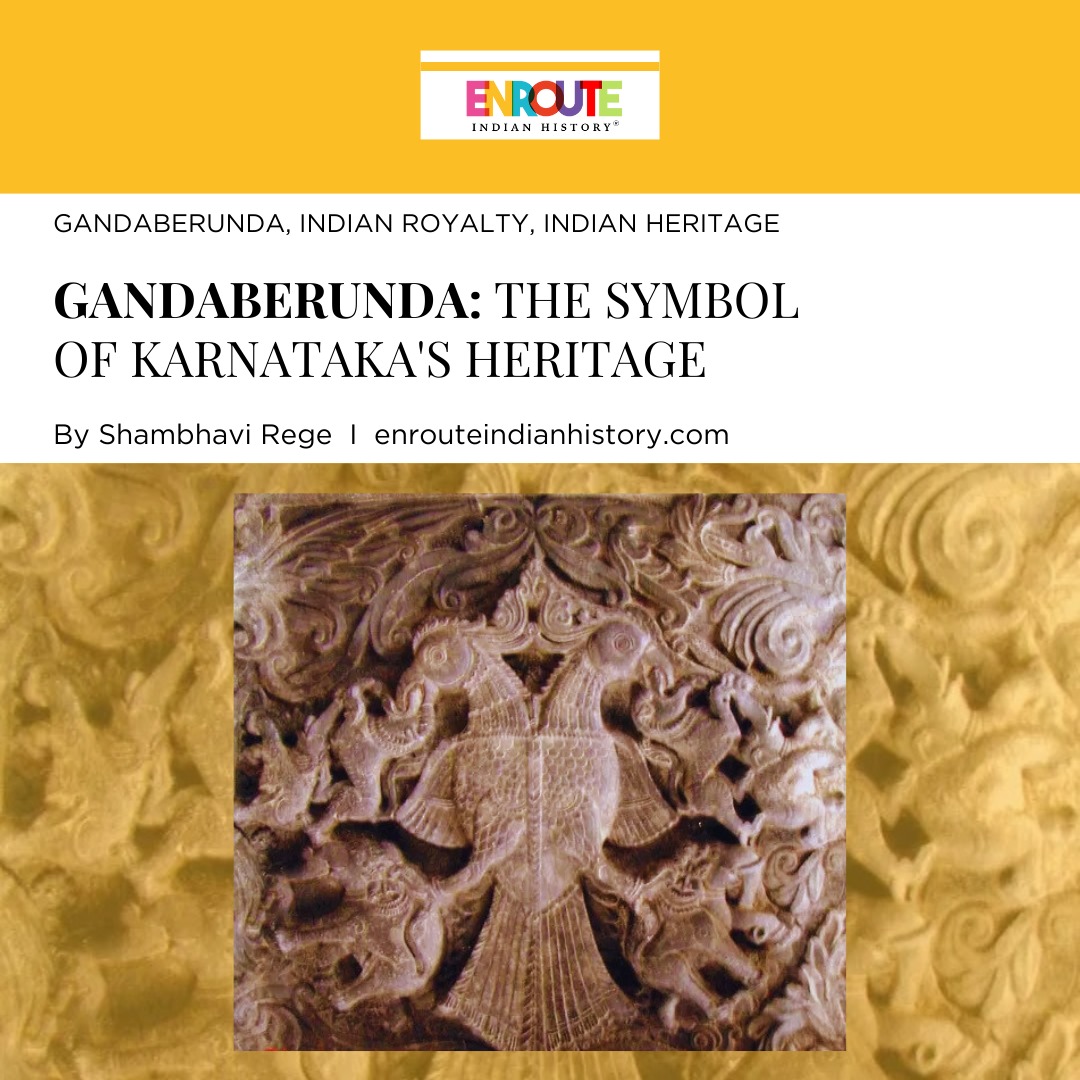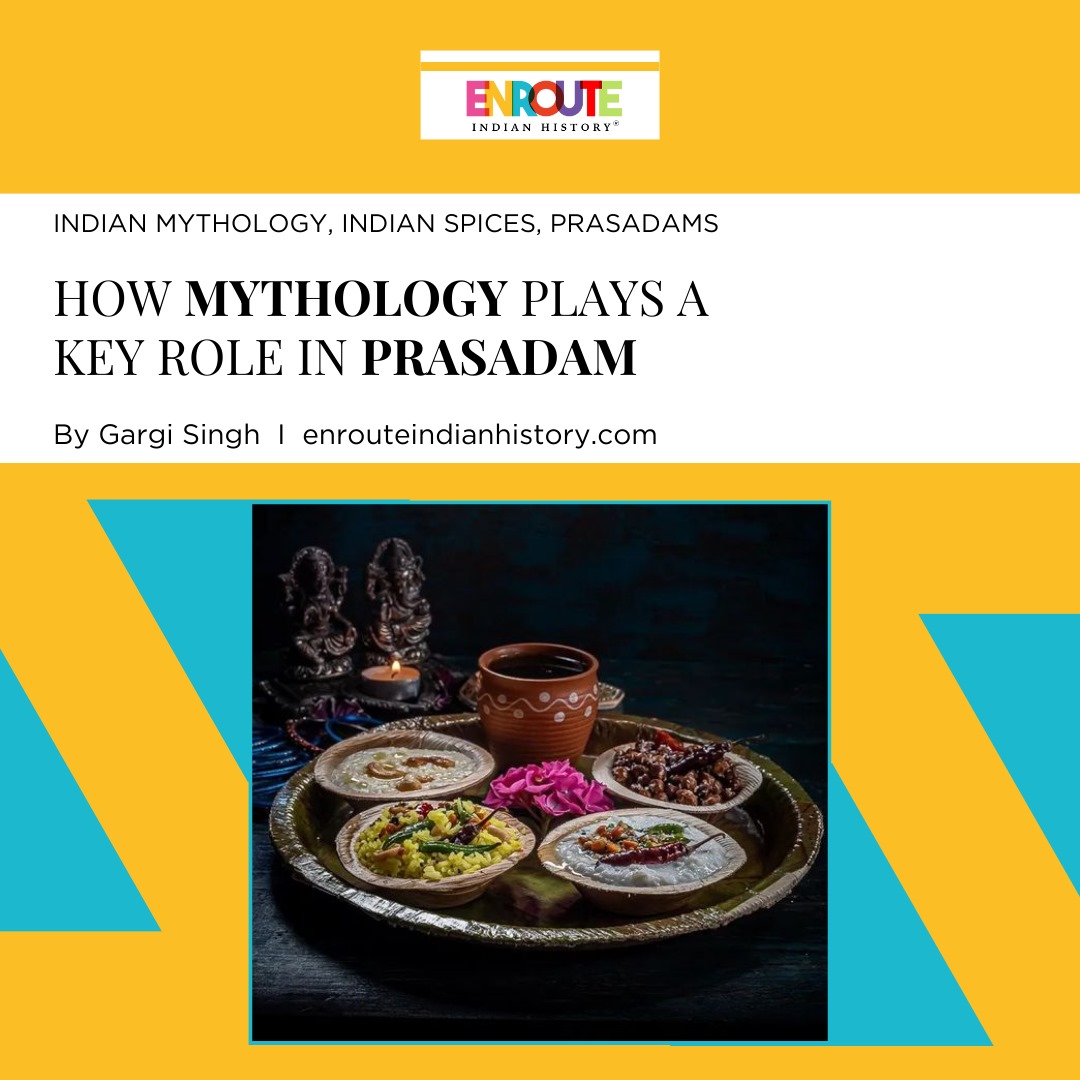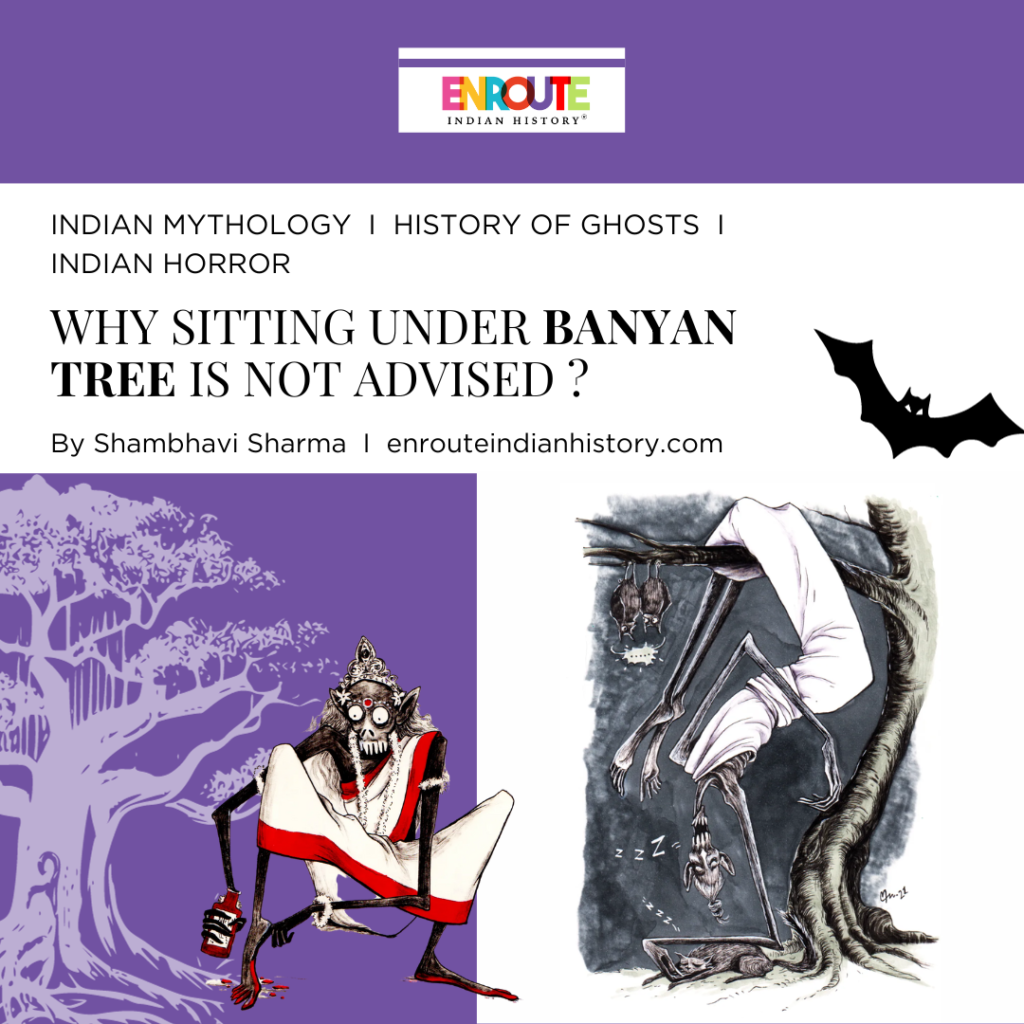
For years, every Indian child has heard the story of Vikram and Betal based on the 11th century AD text ‘Betal Pachisi’ (24 stories of Betal) by poet Somadeva. At the heart of this enthralling saga lies the quest of King Vikramaditya, tasked with capturing a Betal, a spirit that resides atop an ancient banyan tree. Betal, possesses a remarkable penchant for storytelling and enigma, challenging the king with puzzling moral conundrums that intertwine the complexities of human behavior, justice, and the mystical. The narrative of the story where the majestic banyan tree becomes the stage for a series of enigmatic and spine-tingling encounters forms an evocative backdrop that symbolizes the mystic allure and sanctity ascribed to trees in Indian mythology.

Vikram & Betal
In Indian mythology, trees have long held a mysterious and revered status, often believed to be abodes for spirits and supernatural entities. The intertwining of folklore, legend, and spiritual beliefs has endowed these ancient sentinels with a haunting allure, connecting them to tales of ghosts and otherworldly beings.
Certain researchers propose that initially, the veneration of trees possibly preceded the worship of gods and goddesses, likely due to their medicinal properties or symbolic significance. Trees presently hold an indispensable role in the symbolism associated with various deities. For instance, the mango tree is linked to Kama, the god of love, while the Tulsi plant holds a special place in Vishnu’s worship. Bilva is revered in association with Shiva, Dhurva grass is offered to Ganesha, and Neem or Margosa trees are considered sacred to the mother goddess. Moreover, the coconut and banana are symbolic in the worship of Lakshmi.
The Banyan tree, on the other hand, is connected with Yama, the god of death. It is a common practice to plant this tree outside villages, usually near cremation grounds. It is believed to be a dwelling place for spirits, with Vetals (evil spirit who haunts cemeteries and takes demonic possession of corpses) and Pisachas (flesh-eating demons) thought to hang from its numerous branches.
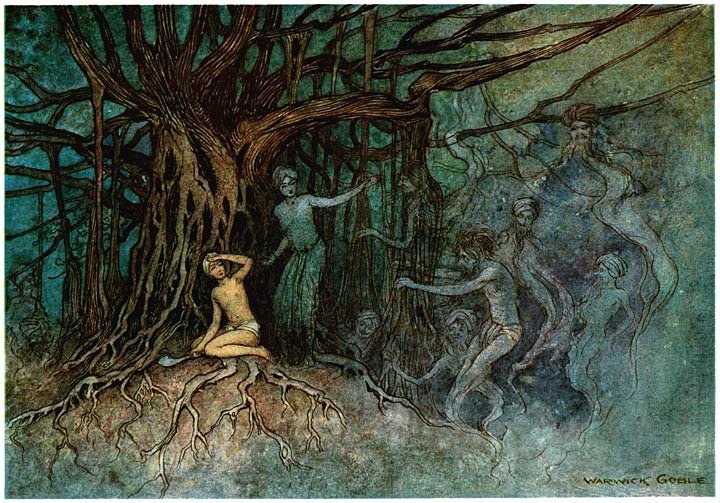
Illustration by W. Goble 1912 via Wikimedia Commons
The Banyan tree, distinguished by its unique characteristics, doesn’t permit the growth of any vegetation underneath it. This attribute symbolizes a lack of space for renewal and rebirth. Despite providing shelter from the sun’s harsh rays, the Banyan tree does not offer sustenance. Consequently, it is notably absent from ceremonies associated with fertility, such as those celebrating marriage and childbirth, where plants known for their quick renewal and capacity to offer food, like Banana, Mango, Coconut, Betel, Rice, and even grass, are integral.
The Banyan tree could be likened to a recluse among trees. Just as a hermit eschews the notion of raising a family, the Banyan tree cannot sustain a household. It doesn’t epitomize the material aspirations of a community but embodies their spiritual yearnings. This tree is often considered immortal, referred to as Akshaya, signifying its survival even through Pralaya, the catastrophic destruction of the world.
Shiva, frequently depicted in the shade of the Banyan tree as a stone symbol known as the Lingam, was an ascetic who resided outside the village, akin to a hermit rather than a householder. Shiva, in the iconography as Dakshinamurti, faces the south, signifying death and transformation. Shiva’s favorite companions are also believed to be Ghosts and other unnatural beings. Due to these various myths, the Banyan tree is believed to be infested with spirits.
Apart from these superstitions, there are practical reasons why sitting under a banyan tree at night might not be advisable, especially during night. The tree’s vast canopy of leaves creates dense darkness, impeding visibility in the absence of light. Additionally, the complex network of its aerial roots can make it challenging to move comfortably or freely underneath. Furthermore, the banyan tree’s large size leads to heightened respiration during the night, producing more carbon dioxide compared to other average trees, which could potentially pose health risks.
Moreover, the caution against planting a Banyan tree near residential compounds or houses is not just a superstition but has a scientific basis. The Banyan tree has an extensive and robust root system that can extend several meters in search of water, they may encroach upon nearby structures, potentially causing damage.
Haunted stories from the four directions
In certain Oriyan tribes, the Simbal tree is believed to be the favored dwelling place of Butt Ambae, a female ghost known for appearing in the dreams of young men, allegedly robbing them of their virility.
Similarly, among specific cultural beliefs, the Babool tree is thought to house an evil spirit, but this spirit only brings harm if a bed is made or repaired using its wood. Such a bed is said to be unsuitable for sleeping in.
Traditional Bengali folklore often associates ghosts with locations outside the home. Trees, marshes, ponds, and forests are frequently linked to these spectral beings. Certain trees have specific affiliations with particular types of ghosts. For instance, the revered Brahmin ghost, the Brahmadaitya, favors the Bel tree, a plant of ceremonial importance as its leaves are traditional offerings to Siva. Female ghosts like the Petni (the unhappy ghost of an unmarried or widowed woman) are associated with the Sheora tree, while the kola-shoot, a common type of Petni, is believed to inhabit banana plants.

Female Ghosts by Manisha Naskar, 2018 v
While many cultures regard the Tamarind tree as holy or a divine abode, there are beliefs in some Indian and Caribbean communities that it is home to ghosts and poses potential curses and dangers. However, according to Dr. RP Parashar, an Ayurvedacharya, the Tamarind tree is said to maintain an acidic layer around it and releases a fluid causing dizziness and nausea due to the acidic air it generates, refuting the supernatural beliefs about ghosts residing in the tree.
Indeed, spirits or ghosts associated with trees are not always depicted as fearsome or malevolent entities; they can also be perceived as benevolent. In southern India, there exists a practice of honoring and revering sacred groves, known locally as “kaavu.” The term “kaavu” is used to refer to these nature temples in both Tamil and Malayalam. In Tamil, “kaavu” signifies a sacrificial offering place. These sacred groves are prevalent in areas that were once part of the Travancore and Cochin principalities, which include present-day regions such as Kanyakumari District and Kerala State.
A “kaavu” or sacred grove is considered a sacred memorial to the ancestors. Typically, a serene and peaceful area with abundant plant life is chosen for this purpose. People believe that the spirits of their ancestors dwell in these groves, offering protection and guidance. Special attention is given to the most prominent and largest tree, often revered with raised platforms constructed around it. This tree is worshipped as the “sthalavriksha,” a term derived from Sanskrit, where “sthala” means place and “vriksha” means tree, akin to the Tamil term “thalamaram.”
In rural areas of Gujarat, it’s common to discover sanctuaries dedicated to Chudail Ma. These sites are recognizable by the vibrant fabrics hung on trees along roadsides or paths. This practice likely continues the traditional Gujarati custom of attaching worn-out clothes to trees where spirits were believed to live. Enthoven’s account mentions the belief that both male and female spirits inhabit Khijado, Baval, and Kerado trees. People drape rags on these trees to deter others from cutting or removing them, and some surround the trees with stones and draw tridents with red lead and oil. These “holy trees” receiving offerings of rags are believed to be the homes of either gods or malevolent spirits
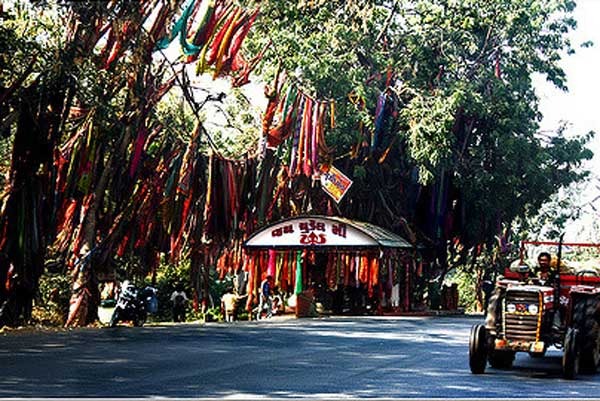
Chudail Mata Mandir, 2016, Photo by Anita Ram
In Indian mythology, the Yakshinis are revered supernatural entities, often associated with trees, forests, and natural landscapes. Yakshinis are considered female nature spirits or mystical beings that embody the untamed beauty and power of the natural world. They are depicted as celestial beings, sometimes benevolent and at other times possessing a more mischievous or fierce demeanor.
These enigmatic spirits are believed to reside in trees, especially in dense forests or ancient groves. Their association with specific trees, such as the banyan or neem trees, lends an aura of mysticism to these sacred sites. According to popular beliefs, performing rituals or prayers at these trees may invoke the blessings or presence of the Yakshinis, who are thought to bestow boons, protection, or even supernatural abilities upon devotees.
Tree Spirits in Urban Legends
In modern times as well, people still consider trees as abodes of ghosts, an example is in the heart of Delhi’s bustling sub-city, Dwarka, a local legend surrounds a particular tree in sector 9 believed to be haunted, this tree also makes the list of one me of the most haunted places in Delhi. Despite the urban setting, the myth of this eerie tree persists among residents. Stories abound of inexplicable sightings and eerie occurrences associated with this specific tree.
In many Bollywood movies as well, the myth that ghost resides in trees are often depicted, In the film “Phillauri,” a young man, is wed to a tree, to correct his “Manglik Dosha” (a person whose first spouse dies according to their birth chart) discovers he’s haunted by the ghost of Shashi, a spirit of young woman who lived on that tree and now claims to be married to him.

Poster of “Phillauri” (2018) via Wikimedia Commons
In Satyajit Ray’s “Goopy Gyne Bagha Byne,” the psychedelic ghost dance sequence unfolds amidst an eerie forest landscape. This surreal scene captures ghostly figures dancing in an otherworldly manner, surrounded by the mystical aura of the dense, wooded setting. The portrayal of ghosts dancing in the forest further accentuates the cultural belief that spirits reside in wooded areas, emphasizing the connection between supernatural beings and the enigmatic allure of the forest.
The spectral association of trees in Indian mythology as abodes for ghosts stands as a testament to the enduring intersection of folklore, spirituality, and cultural beliefs. Through centuries-old tales, trees have symbolized a connection between the mortal and the ethereal, regarded as sanctuaries for spirits and supernatural beings. These mythical beliefs, deeply embedded in the collective consciousness, reflect a profound reverence for nature and the mystical realms. Though practical reasons for health and safety are cited often, most people still believe in the myths and legends passed on to them for generations which might even be based on reality for many.
REFERENCES:
- Menzies, J. (Ed.). (2007). Goddess: Divine Energy. Thames & Hudson.
- L Haberman, D. (2013). People Trees: Worship of Trees in Northern India. Oxford University Press, New York.
- Sukumaran, & Raj, A. D. S. (2008). EVOLUTION OF STHALAVRIKSHA WORSHIP CONCEPT THROUGH THE SACRED GROVES IN KANYAKUMARI DISTRICT, TAMIL NADU, INDIA. Journal of Basic and Applied Biology (an International Journal of Biological Research), 45.
- Under the Banyan tree. (2023, July 12). Devdutt Pattanaik. https://devdutt.com/under-the-banyan-tree/
- M. Gupta, S. (in press). PLANT MYTHS & TRADITIONS IN INDIA. Vidyaonline.org.
- Desk, L., & Desk, L. (2022, June 2). From Shelter To Spirits, Astonishing Facts About Tamarind Tree. News18. https://www.news18.com/news/lifestyle/from-shelter-to-spirits-astonishing-facts-about-tamarind-tree-5299099.html
- April 25, 2024
- 14 Min Read
- February 16, 2024
- 8 Min Read




